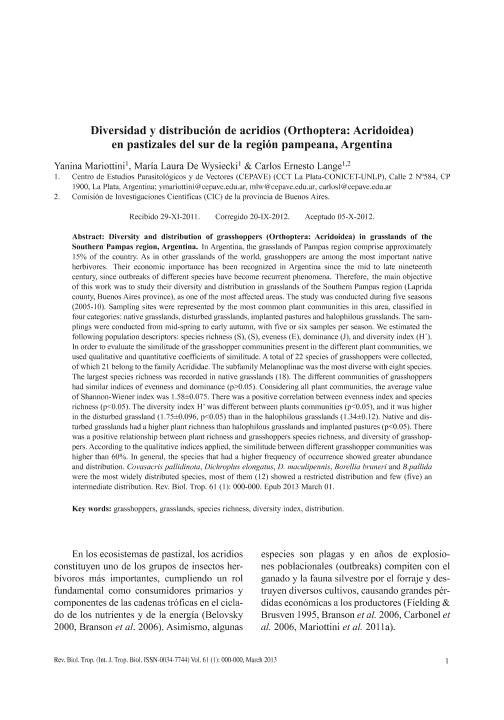Mostrar el registro sencillo del ítem
dc.contributor.author
Mariottini, Yanina

dc.contributor.author
de Wysiecki, Maria Laura

dc.contributor.author
Lange, Carlos Ernesto

dc.date.available
2016-01-06T20:21:32Z
dc.date.issued
2013-07
dc.identifier.citation
Mariottini, Yanina; de Wysiecki, Maria Laura; Lange, Carlos Ernesto; Diversidad y distribución de acridios (Orthoptera: Acridoidea) en pastizales del sur de la región pampeana, Argentina; Universidad de Costa Rica; Revista de Biología Tropical; 61; 1; 7-2013; 111-124
dc.identifier.issn
0034-7744
dc.identifier.uri
http://hdl.handle.net/11336/3394
dc.description.abstract
In Argentina, the grasslands of Pampas region comprise approximately 15% of the country. As in other grasslands of the world, grasshoppers are among the most important native herbivores. Their economic importance has been recognized in Argentina since the mid to late nineteenth century, since outbreaks of different species have become recurrent phenomena. Therefore, the main objective of this work was to study their diversity and distribution in grasslands of the Southern Pampas region (Laprida county, Buenos Aires province), as one of the most affected areas. The study was conducted during five seasons (2005-10). Sampling sites were represented by the most common plant communities in this area, classified in four categories: native grasslands, disturbed grasslands, implanted pastures and halophilous grasslands. The samplings were conducted from mid-spring to early autumn, with five or six samples per season. We estimated the following population descriptors: species richness (S), (S), eveness (E), dominance (J), and diversity index (H´). In order to evaluate the similitude of the grasshopper communities present in the different plant communities, we used qualitative and quantitative coefficients of similitude. A total of 22 species of grasshoppers were collected, of which 21 belong to the family Acrididae. The subfamily Melanoplinae was the most diverse with eight species. The largest species richness was recorded in native grasslands (18). The different communities of grasshoppers had similar indices of evenness and dominance (p>0.05). Considering all plant communities, the average value of Shannon-Wiener index was 1.58±0.075. There was a positive correlation between evenness index and species richness (p<0.05). The diversity index H’ was different between plants communities (p<0.05), and it was higher in the disturbed grassland (1.75±0.096, p<0.05) than in the halophilous grasslands (1.34±0.12). Native and disturbed grasslands had a higher plant richness than halophilous grasslands and implanted pastures (p<0.05). There was a positive relationship between plant richness and grasshoppers species richness, and diversity of grasshoppers. According to the qualitative indices applied, the similitude between different grasshopper communities was higher than 60%. In general, the species that had a higher frequency of occurrence showed greater abundance and distribution. Covasacris pallidinota, Dichroplus elongatus, D. maculipennis, Borellia bruneri and B.pallida were the most widely distributed species, most of them (12) showed a restricted distribution and few (five) an intermediate distribution
dc.format
application/pdf
dc.language.iso
spa
dc.publisher
Universidad de Costa Rica
dc.rights
info:eu-repo/semantics/openAccess
dc.rights.uri
https://creativecommons.org/licenses/by-nc-nd/2.5/ar/
dc.subject
Grasshoppers
dc.subject
Species Richness
dc.subject
Diversity Indices
dc.subject
Distribution
dc.subject
Grasslands
dc.subject.classification
Zoología, Ornitología, Entomología, Etología

dc.subject.classification
Ciencias Biológicas

dc.subject.classification
CIENCIAS NATURALES Y EXACTAS

dc.title
Diversidad y distribución de acridios (Orthoptera: Acridoidea) en pastizales del sur de la región pampeana, Argentina
dc.title
Diversity and distribution of grasshoppers (Orthoptera: Acridoidea) in grasslands of the Southern Pampas region, Argentina
dc.type
info:eu-repo/semantics/article
dc.type
info:ar-repo/semantics/artículo
dc.type
info:eu-repo/semantics/publishedVersion
dc.date.updated
2016-03-30 10:35:44.97925-03
dc.journal.volume
61
dc.journal.number
1
dc.journal.pagination
111-124
dc.journal.pais
Costa Rica

dc.journal.ciudad
San José de Costa Rica
dc.description.fil
Fil: Mariottini, Yanina. Consejo Nacional de Investigaciones Científicas y Técnicas. Centro Científico Tecnológico La Plata. Centro de Estudios Parasitológicos y de Vectores (i); Argentina
dc.description.fil
Fil: de Wysiecki, Maria Laura. Consejo Nacional de Investigaciones Científicas y Técnicas. Centro Científico Tecnológico La Plata. Centro de Estudios Parasitológicos y de Vectores (i); Argentina
dc.description.fil
Fil: Lange, Carlos Ernesto. Consejo Nacional de Investigaciones Científicas y Técnicas. Centro Científico Tecnológico La Plata. Centro de Estudios Parasitológicos y de Vectores (i); Argentina. Provincia de Buenos Aires. Gobernación. Comisión de Investigaciones Científicas; Argentina
dc.journal.title
Revista de Biología Tropical

dc.relation.alternativeid
info:eu-repo/semantics/altIdentifier/url/http://revistas.ucr.ac.cr/index.php/rbt/article/view/10888
dc.relation.alternativeid
info:eu-repo/semantics/altIdentifier/url/http://www.redalyc.org/articulo.oa?id=44925650002
dc.relation.alternativeid
info:eu-repo/semantics/altIdentifier/doi/http://dx.doi.org/10.15517/rbt.v61i1.10888
Archivos asociados
